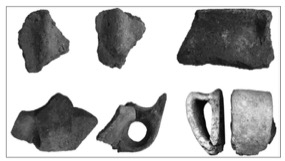Handles with raised parts (Thomes)
Among the ceramic artefacts found in the tomb of Thomes and on display in the Archaeological Museum of Dorgali, there are four ceramic fragments a few centimetres long which belong to a particular class of raised handles which have horned lugs (figs. 1,2,3,4) pertaining to ceramic types such as cups used as tableware, or carenated vessels and/or olla with a separate rim and a globular body used at home for cooking and storing food (figs. 5, 6).
The vessels to which they belong were shaped by hand using a totally non-purified clay, with a coarse mixture, containing many foreign bodies; the surfaces are greyish-brown and reddish-brown. In order to level out the outer surface of the vessel, it was smoothed before being fired.


(photo by Unicity S.p.A.).


For ceramics belonging to the Early Middle Bronze Age Culture in Sardinia called Sa Turricula (1600-1500 B.C.), this particular type of handle, which is common among other things to nearly all other known Sardinian contexts of this period (e.g. the giants’ tomb of Thomes-Dorgali, the giants’ tombs of Li Lolghi and Coddu Vecchiu in the territory of Arzachena, Su Picante near Siniscola, and the dolmen of Mariughia Dorgali), is considered a sort of index fossil, i.e. an essential tool which allows determining the date of the vessel to which it belongs.


Bibliografia
- DEPALMAS A., Il Bronzo Medio della Sardegna, in Atti della XLIV Riunione Scientifica. La Preistoria e la Protostoria della Sardegna, Firenze 2009, pp. 49-58.
- MANUNZA M. R., La ceramica prenuragica e nuragica, in Ceramiche. Storia, linguaggio e prospettive in Sardegna, Nuoro 2007, pp. 13-47.
- MELIS P., Lo scavo della Tomba II nella necropoli dell’Età del Bronzo di Sa Figu (Ittiri-SS), in USAI L. (a cura di), Erentzias, Rivista della Soprintendenza per i Beni Archeologici per le province di Sassari e Nuoro, Sassari 2011, pp. 101-117.
- MORAVETTI A., Tombe di giganti nel Dorgalese, in Dorgali. Documenti Archeologici, Sassari 1980, p. 93, Tav. XXX. 2,3,4,5.
- PULACCHINI D., Il museo archeologico di Dorgali, Sardegna Archeologica. Guide e itinerari, 27, Sassari 1998, p. 17.

 VR
VR